Snakes
have gotten a bad rap ever since that apple episode
in the Garden of Eden. Even St. Patrick, the patron
saint of Ireland, drove the proverbial pagan snakes
from Ireland. Whereas a desert bighorn or sleeping
kit fox might send folk scurrying for their cameras,
a snake sighting usually sends people in search of
a shovel.
One summer when I worked as a Park Ranger in Arches
National Park, I lived in an old trailer at the campground
entrance. This was our “residence” although
people walked into our “home” uninvited
all the time. Expected but not exactly encouraged,
visitors would show up at all hours of the day – but
it was the really late night visits that drove me crazy.
A fairly common late night complaint had to do with
rattlesnakes in the men’s bathroom. Not that
they were taking too long, but that the snakes were
coiled up near the doorway, refusing to grant entry
to those in need. “You’ve got to get them
out of there,” people complained. I agreed, often
for the snake’s safety more than the visitor’s
comfort level. I’d learned about vigilante visitors
the hard way – two halves of a snake do not make
a whole.
I would grab a shovel and a flashlight and walk up
to the restroom. The midget-faded rattlesnakes that
occur in this area are pretty mellow, so sometimes
all I had to do was prop open the restroom door and
give the snake a gentle nudge with the shovel. Other
times, I might scoop up the coiled serpent while its
tail buzzed a greeting like a Bronx cheer. Once outside,
the snakes slithered off to safety, but rarely did
the visitors reenter the restroom.
Other times it would be gopher snakes that had the
visitors “concerned.” Much larger than
the midget-fadeds, these snakes have black blotches
on their backs and lack the triangular-shaped head
of a pit viper. Though lacking a “rattle” at
the tip of their tail, gopher snakes do their best
rattlesnake imitation when confronted with danger.
They coil up, raise and flatten their head, vibrate
their tail, and strike a rattlesnake pose.
Once again, a gentle prod from a shovel or lifting
one up like cooked spaghetti often encouraged the snakes
to depart. Of course, these were prime opportunities
to chat with folks about the natural history of these
snakes and to praise their benefits as mousers, rattlesnake
foes and prey for hawks.
Only once have I observed a red-tailed hawk flying
with a gopher snake clutched in its talons. The bird
was moving too fast for me to tell if the snake was
dead or alive; I presumed that the snake had been dispatched.
I’m sure the hawk’s nestlings would have
reacted like the restroom visitors when a live snake
was dropped into their nest.
Garters and Whipsnakes
Two other non-venomous snakes that occur in Canyon
Country are the western terrestrial garter snake and
the striped whipsnake. I’ve seen the garter snake
in riparian habitats – wetlands, canyon bottoms,
wet meadows, or near the river.
These snakes are excellent swimmers. The whipsnakes,
named for their sleek body, are more arboreal than
the other snakes. They climb up into shrubs and tamarisk
limbs to hunt or escape from predators. I’ve
only seen a few of these snakes in over 25 years of
hiking in the desert.
Once I stumbled upon one in action trying to devour
a Clark’s spiny lizard. The lizard was far too
large for the snake, but the snake must have felt optimistic.
Unfortunately for the snake, the lizard bolted to freedom
after a brief struggle.
So next time you happen onto a snake, take a moment
to consider your options. Your chances of being zapped
by lightning are far greater than being bitten by a
venomous snake. My vote would be to go for the camera,
but forgo the close-up lens.
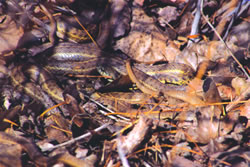
|
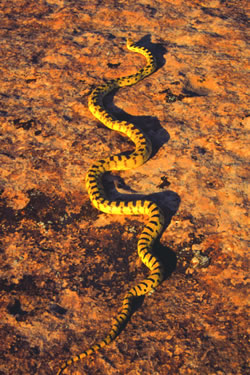
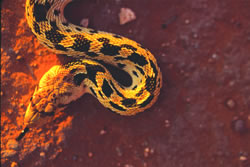
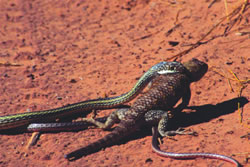
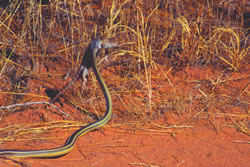
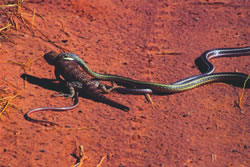
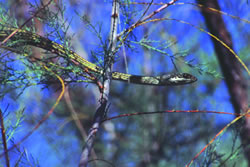
|